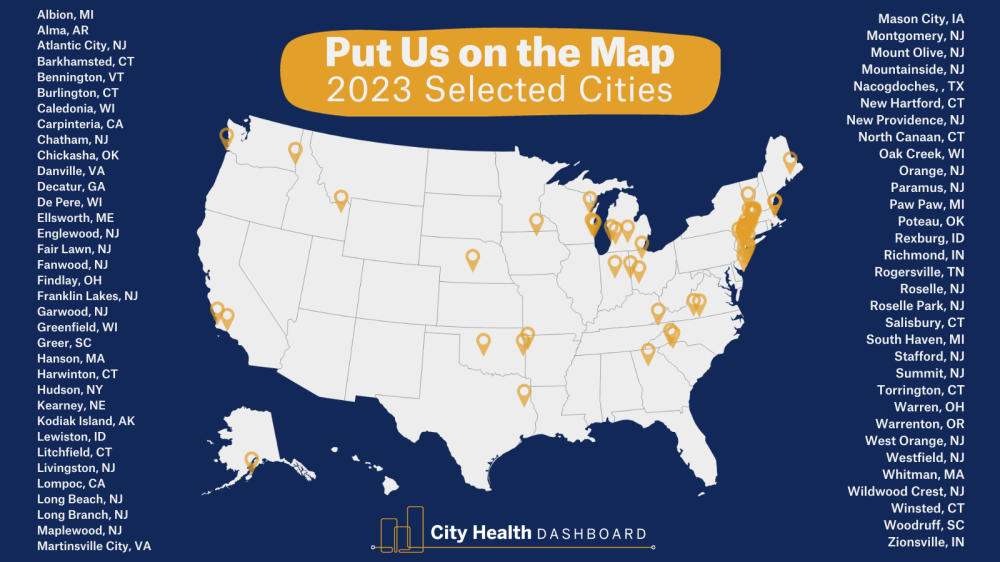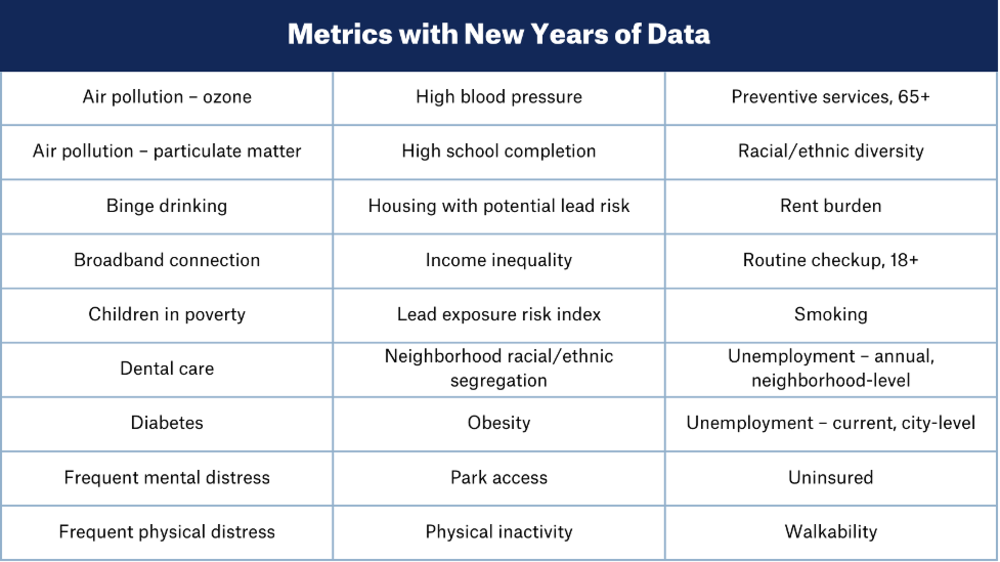Summer Site Updates: New Cities, Metric Updates, and More!
Jul. 27, 2023
Caleigh Paster
We’re making the most out of the summer at the City Health Dashboard! This year marked our 5 year anniversary, which we celebrated in June with a commemorative blog and a short video featuring users from across the country.
As we continue to build on our growth, we are excited to announce July’s data release. This release includes more cities as we grow the number of communities we serve, both big and small, as well as new years of data for many of our metrics, updates to the timeliness of the measures on the site, and improvements to the downloadable data.
Read on to learn more about what we’ve updated this month.
Welcoming 67 New Cities to the Dashboard!
For the second year in a row, small to midsize cities across the nation applied to join the Dashboard through our Put Us on the Map Challenge. From a record number of applications, we selected 67 cities – with populations ranging from 3,000 to 50,000 – to get put on our map and gain access to critical public health data. These cities come from every region in the U.S., covering 23 different states. Read more about this year’s selected cities and check up on last year’s picks who are using Dashboard data to make a difference in their communities.

New Years of Data
This data release introduces new years of data for 27 metrics. Among those with updates includes 11 metrics from the American Community Survey which now have data through 2021, 11 metrics from the PLACES Project which have data through 2020, as well as the Park Access and Walkability metrics which have data through 2022. Additionally, our three monthly measures – both ozone and particulate matter air pollution metrics as well as unemployment – will have new data through December 2022. See below for a full list of metrics with new years of data.

These new years of data allow users to see how changes over time may affect cities, providing essential context for policies and programs aimed at addressing these issues.
Keeping Measures Timely
Replacing Air Pollution – Particulate Matter
With rising temperatures around the globe and increasing health risks during fire season due to smoke, air quality has been top of mind. The Dashboard works to remain timely with our measures, including making updates to existing ones when necessary. The Dashboard provides two air pollution metrics on the site: Ozone and Particulate Matter. Historically, the Ozone metric on the site provides monthly estimates while the Particulate Matter measure provided annual estimates.
Starting today, the Dashboard now presents Particulate Matter using a new data source that allows us to provide monthly estimates. The new data source comes from George Mason University, the same provider of our Ozone metric, and is available at both the city and neighborhood level for all Dashboard cities. Data availability on the site will now start from January 2022 to December 2022, with additional data provided during future data releases. Previous years of data using the prior data source will also no longer be available for download as this data is not as granular as our new source.
Learn more about Particulate Matter and explore these new data for your city.
COVID Milestones – Removal of the COVID Local Risk Index
This year, the U.S. officially ended the national public health emergency regarding the COVID-19 pandemic, marking a huge milestone in our health efforts to combat this disease. The COVID Local Risk Index was added back in June 2020 in quick response to the growing pandemic and the needs from communities across the country. Now, two and a half years later, that need has changed. Due to shifting circumstances and priorities in regards to COVID, we have made the decision to remove the COVID Local Risk Index from the Dashboard.
While the metric will no longer be available on the site, data will still remain available for download – just email us your data request and we will be happy to provide the data for your research purposes.
Though Monthly Unemployment was also added to the site due to pressures from the COVID pandemic, this measure will remain as the need for timely unemployment data has held steady. Additionally, with the end of the national public health emergency, other metrics on the Dashboard may be useful in understanding these implications at the city-level. Particularly, with Medicaid disenrollments resuming as of May 2023, Uninsurance data may provide insight into how access to affordable care shifts pre- and post-pandemic.
Reassessing Metrics – Removing Limited Access to Healthy Foods
The Dashboard evaluates each metric regularly to ensure that the data we are providing to cities remains in line with our high standards for statistical rigor and external validity. When our team discovers questions about methodology or user-relevance, we remove the metric from the site, continuing our internal research and development for potential replacements. Unfortunately, in our most recent consideration of metrics, we have made the decision to remove Limited Access to Healthy Foods.
In this case, we questioned whether the ½ mile distance to a supermarket – which the measure is inherently based upon – is an appropriate cut-off for all cities, both urban and rural. Additionally, this measure lacked inclusion of alternative sources of healthy foods, such as farmer’s markets and local convenience stores. Finally, we discovered methodology questions related to recurring missing values. These reasons provided us with sufficient evidence to make the decision to remove the metric and focus internal efforts on finding a replacement measure on food access and insecurity in the near future. Be sure to subscribe to hear updates about any future metrics.
Improving the User Experience: Updates to the API
As part of our efforts to continually improve the site, the API will be temporarily unavailable on the Dashboard. This closure is due to a site restructuring that improves the Dashboard’s speed and user experience. Additionally, the updates to the API will allow for more efficient future data releases. Though we do expect to provide the API again shortly, we apologize for the inconvenience during this period. Multi-year data is available upon request and the Dashboard team is always available to answer any data questions by emailing us at [email protected].